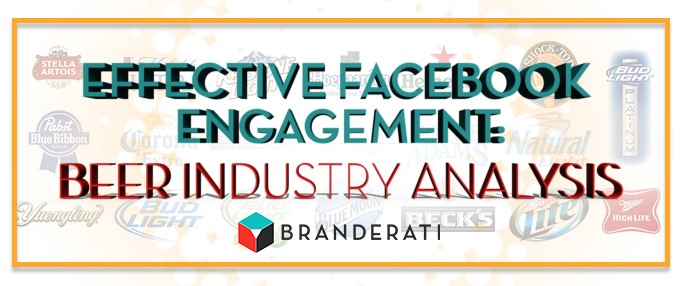Success and the impact of your Facebook community can be defined in several ways. But commonly used metrics such as fan size and engagement percentage don’t tell the whole story. To truly measure the effectiveness of your Facebook communities you need to understand post effectiveness and competitive ranking.
It’s become fairly standard to track metrics such as the size of the community, post frequency, and engagement. Indeed, these are all important parts of the bigger picture and need to be considered. At BRANDERATI, though, we take the analysis one step further and look deeper into the data. We measure the overall page and post effectiveness (more on this below) and compare brands’ performance against their key competitors. You see, to determine the overall success of a Facebook page it is crucial to look at measures that will offer a weighted balance of size and engagement effectiveness, as well as look at how the community performs against other similar communities in the digital ecosystem.
In order to demonstrate these concepts, let’s look at the 20 of the world’s leading beer brands and their Facebook communities. Using BRANDERATI proprietary social analytics tools, we analyzed these 20 communities over a 90 day period.
The brands analyzed include (in no particular order): Bud Light, Budweiser, Coors Light, Michelob Ultra, Bud Light Platinum, Miller Lite, Stella Artois, Shocktop, Heineken, Sam Adams, Blue Moon, Bud Light Lime, Pabst Blue Ribbon, Yuengling, Natural Light, Becks, Miller High Life, Corona, Keystone Light, Hoegaarden.

Fan Size
If you just look at the fan size, it comes as no surprise that socially-savvy and popular brands like Heineken, Budweiser, and Bud Light have the most Facebook fans of all of the beer brands. These communities exceed 10 million fans, and on average post 1.3 – 2.3 times per day.

Engagement
The ranking change dramatically when you compare fan size to engagement. Bud Light moves from distant third in fan size to a dominant first place in engagement. Conversely, Heineken seems to be significantly underperforming in engagement as it ranks 9th in engagement despite having the most fans. Interestingly, Michelob Ultra appears in the top 10 – ranks 4th in engagement – despite not even making the top 10 in fan size.
But what’s more interesting than the total engagement (defined as actions taken around the content: likes, comments, shares) is the EdgeRank Action (ERA) measure. We define ERA as the measurement of Facebook actions (likes, comments and shares) weighted to reflect the Facebook algorithm that governs what is displayed, and how high, on the NewsFeed (likes being worth 1 point, comments – 4 points, shares – 10 points).
ERA = Likes + (Comments x 4) + (Shares x 10)
Your goal as a brand is to make it to the NewsFeed as often as possible, so that you stay on top of mind of your fans. The higher the rank of the page, the higher chance you have of more people seeing your posts. And that is what drives awareness, engagement, and organic fan growth. But every action is not weighted the same by the Facebook NewsFeed algorithm, hence the ERA becomes critically important to track and measure on the ongoing basis. Think about ERA measure as a quality of your community engagement.
ERA is important because if you aren’t optimizing your content for engagement, Facebook will decrease the reach of that content. You may have 1M fans, but failing to measure what types of content they want to engage with means fewer and fewer of them will see what your posting. Decreased impressions means decreased engagement, and the descending circle continues.
On the chart below is hows that the BudLight is clearly a leader in not only generic engagement, but also in ERA.
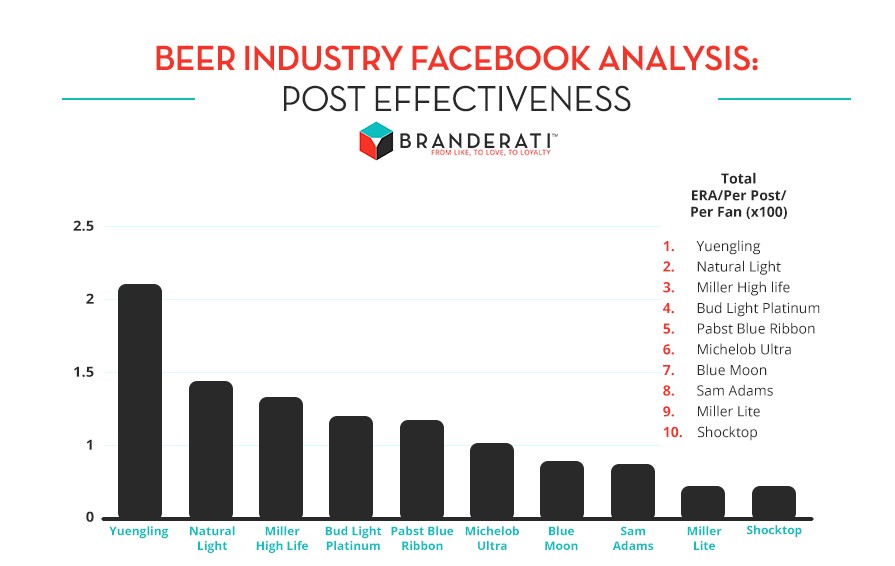
Post Effectiveness
And this brings us to the heart of the matter – Post Effectiveness.
Post Effectiveness=Total ERA / #of Posts / #of Fans
Post Effectiveness measures a page’s total engagement on a per-fan, per-post basis.Doesn’t matter how larger your community it. Doesn’t matter how often you post. What matters is the quality of your content. Are you listening to the community and giving them more of what they want, or just blasting out broad messages?
How effectively does your brand engage its audience per post, per fan? Win at this game, and you will have a serious advantage over your competitors. Combined with an aggressive posting schedule any smaller brand can make much bigger players with much bigger budgets simply look ineffective from an engagement stand point.
Case in point:
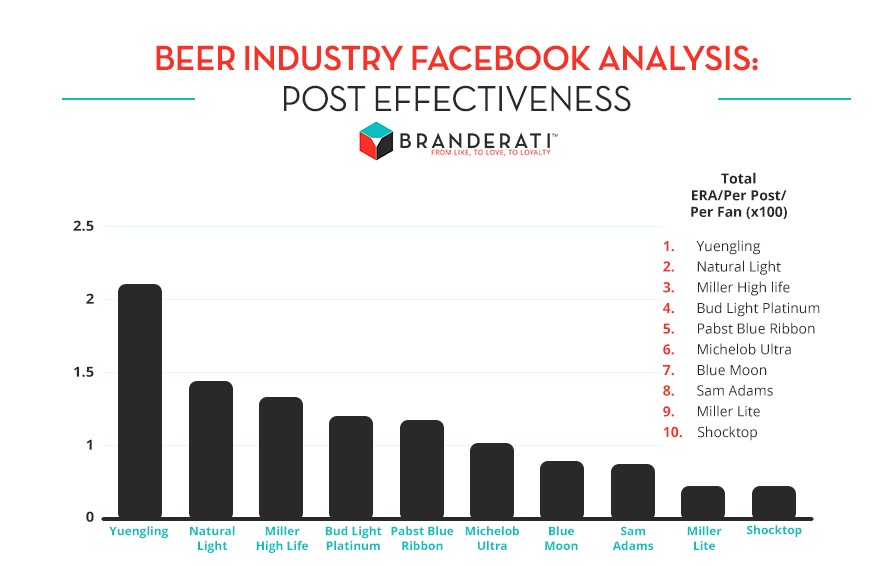
Tellingly, Heineken ranks near the bottom in terms of post effectiveness. On the opposite end of the spectrum, some of the smaller brands scored highest in terms of post effectiveness, including Yuengling and Natural Light. Although these brands have relatively small communities with fewer than 250,000 fans and on average post less than once a day, these posts were extremely popular and earned high levels of engagement per fan per post.
Overall Facebook Community Effectiveness
Without a combination of scale and post effectiveness, however, neither of those two brands cracked the top 10 in overall engagement. In fact, as the size of your community grows, it becomes that much harder to engage every fan with every post.
So who really is standing out with the great combination of scale and post effectiveness? In our analysis, we see Bud Light Platinum and Michelob Ultra as standout performers, followed by Miller Light, Shocktop and Sam Adams.
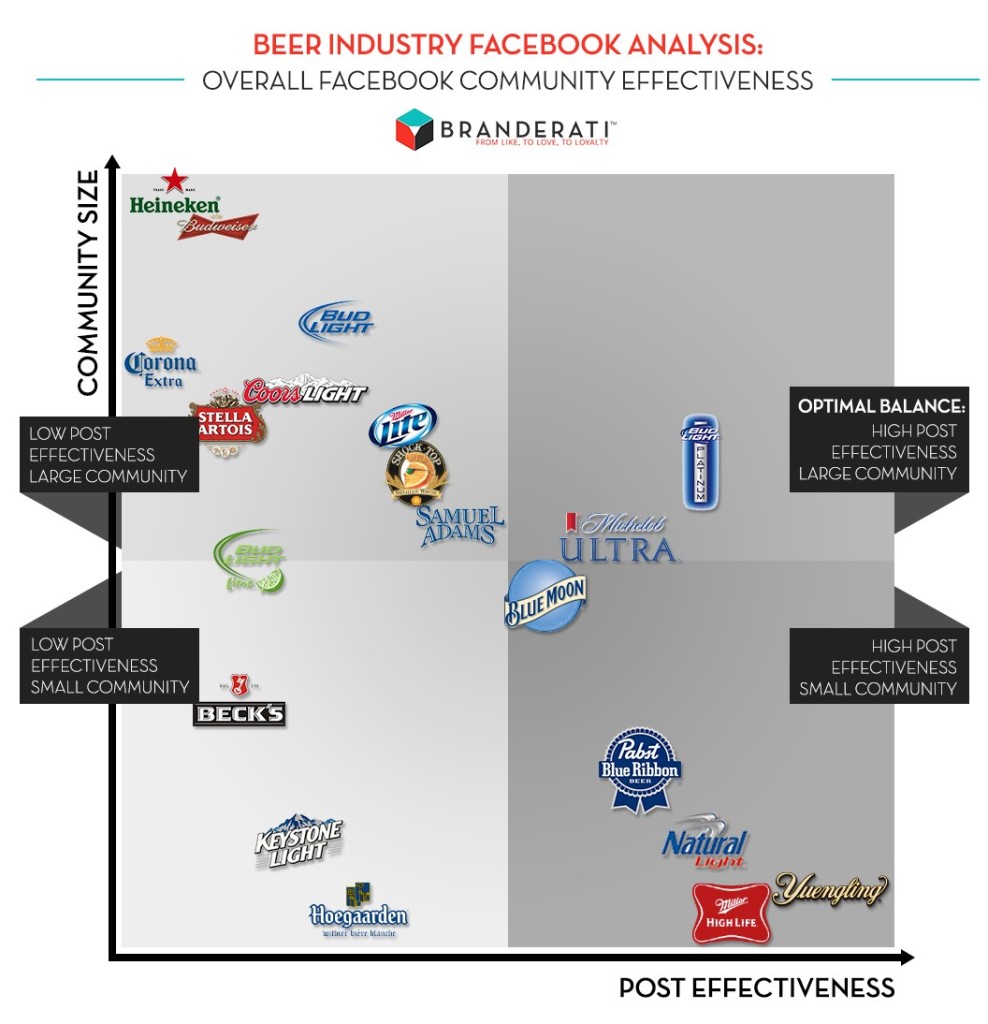
A Closer Look: Bud Light Platinum
Bud Light Platinum has a fairly large community of 1 million fans, and they post an average of 1.2 times per day. For a community of that size, they have extremely high engagement rates. We took a deeper look into what types of content Bud Light Platinum is posting to learn why their content is so successful in engaging fans.
The brand Facebook page has an extremely consistent visual and social theme. The content of the page revolves almost exclusively around trendy high end nightlife. Most of the posts feature top nightlife destinations including Las Vegas, bottle service nightclubs, and music festivals. Some of these nightlife images incorporate the product as well. Bud Light Platinum utilizes the hashtags #PlatinumNight and #MakeItPlatinum to clearly display their focus on nightlife. In addition, they are running a scavenger hunt contest sponsored by Justin Timberlake that ties into their nightlife theme.
Visually, all of the Facebook posts are designed very similarly. Whether the designed image is a product image or location-focused, they all have the same color scheme of black, white, and royal blue. This distinct coloring ties all of the images together and creates a consistent tone for the page that reinforces the brand recognition.
Unlike many of the other beer brands that post a wide variety of content, Bud Light Platinum has been successful by creating a consistent theme and content strategy that their fans clearly identify with. When fans think Bud Light Platinum, they immediately think a fantastic night out.
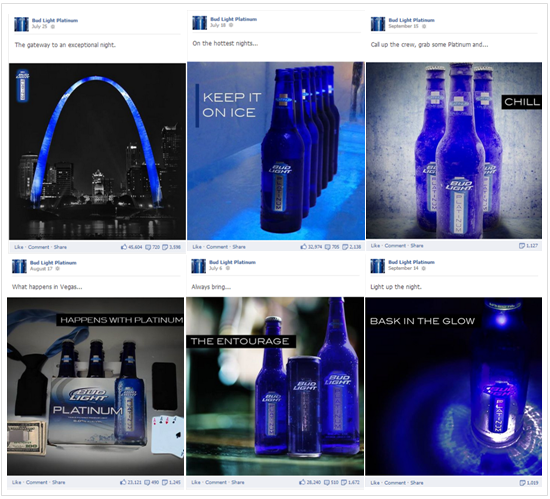
So What?
What can you do with this type of information if you’re trying to compete in this space?
For one, by tracking top performers such as Bud Light Platinum, you can reverse engineer best practices to find brand-appropriate ways to leverage these tactics for your brand.
Furthermore, using social analytics tools and meaningful data you can create a solid content strategy. For example, through tagging your posts, you can identify the types of content that work (and do more of that!), and the types of content that don’t (and do less of that!).
Finally, the overall competitive context gives you the ability to set meaningful goals (metrics) to achieve in terms of post effectiveness, post frequency and overall engagement with your community.
These are just some of the strategies you can use to help your community become the most engaged and recognized community in your industry.
For a more detailed analysis please email us at contact@branderati.com
Originally Posted on BRANDERATI

